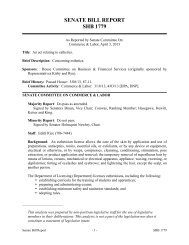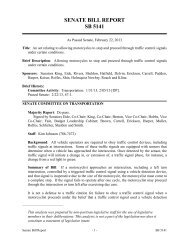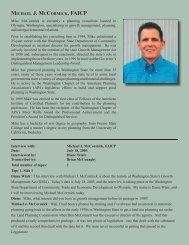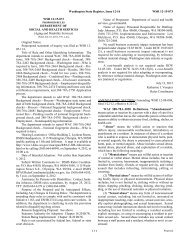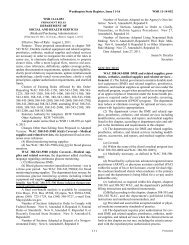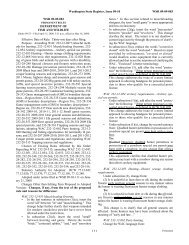Proposed
Proposed
Proposed
You also want an ePaper? Increase the reach of your titles
YUMPU automatically turns print PDFs into web optimized ePapers that Google loves.
WSR 12-21-132 Washington State Register, Issue 12-21<br />
Name of Agency Personnel Responsible for Drafting,<br />
Implementation and Enforcement: Tom Wessels, 1111<br />
Washington Street S.E., Olympia, WA 98504-2560, (360)<br />
902-1984.<br />
No small business economic impact statement has been<br />
prepared under chapter 19.85 RCW. The proposed rule will<br />
not have a more than minor economic impact on the commercial<br />
hazelnut industry. Chapter 15.13 RCW already requires<br />
all horticulture plants shipped into the state to be certified<br />
free of plant pests, so this more specific rule proposal would<br />
furnish specific protections to hazelnut growers, but not add<br />
additional economically consequential regulations to Washington<br />
businesses. In addition, neglecting to establish a quarantine<br />
specific to eastern filbert blight may result in extensive<br />
economic loss to the Washington hazelnut crop.<br />
A cost-benefit analysis is not required under RCW<br />
34.05.328. The Washington state department of agriculture<br />
is not a listed agency under RCW 34.05.328 (5)(a)(i).<br />
October 24, 2012<br />
Mary A. Martin Toohey<br />
Assistant Director<br />
Chapter 16-474 WAC<br />
EASTERN FILBERT BLIGHT QUARANTINE<br />
NEW SECTION<br />
WAC 16-474-001 Eastern filbert blight—Establishing<br />
quarantine. A quarantine is established under chapters<br />
17.24 and 15.13 RCW to protect the Washington hazelnut<br />
industry from exotic strains of the eastern filbert blight disease.<br />
Eastern filbert blight is a highly infectious plant disease<br />
affecting hazelnuts (also called filberts) and closely related<br />
species. It is caused by the fungus Anisogramma anomala.<br />
Until recently, varieties of hazelnuts grown in the Pacific<br />
Northwest were resistant to the local strain of A. anomala.<br />
However, more virulent strains of A. anomala have been<br />
found in the eastern portion of the United States. If these<br />
more virulent, exotic strains are introduced into Washington,<br />
the disease resistance of local commercial and ornamental<br />
varieties of hazelnuts will decline and may be lost, resulting<br />
in potentially devastating economic consequences to growers,<br />
loss of ornamental or landscape hazelnut plants, and<br />
environmental consequences of removing habitat and food<br />
sources for wildlife.<br />
NEW SECTION<br />
WAC 16-474-005 Eastern filbert blight—Definitions.<br />
"Department" means the Washington state department of<br />
agriculture.<br />
"Eastern filbert blight" means a disease of hazelnut<br />
plants caused by the fungus Anisogramma anomala.<br />
"Hazelnut plant" means plants and plant parts of any species<br />
in the genus Corylus.<br />
"Micropropagate" means plant propagation using aseptic<br />
laboratory techniques and artificial culture medium.<br />
<strong>Proposed</strong> [ 180 ]<br />
"Pest free area" means an area where eastern filbert<br />
blight does not occur, as demonstrated by scientific evidence,<br />
and where this condition is being officially maintained.<br />
"Phytosanitary certificate" means a certificate issued by<br />
a government agency under authority of state or federal statute,<br />
which declares or establishes the pest status of a shipment<br />
of plants or plant parts under accepted inspection or<br />
sampling procedures. Phytosanitary certificates are patterned<br />
after model certificates of the International Pest Protection<br />
Convention.<br />
NEW SECTION<br />
WAC 16-474-010 Eastern filbert blight—Area under<br />
quarantine. The area under quarantine consists of all states<br />
and territories of the United States outside of the state of<br />
Washington.<br />
NEW SECTION<br />
WAC 16-474-015 Eastern filbert blight—Regulated<br />
articles. All plants and plant parts of any species of the genus<br />
Corylus are regulated, except edible nuts that are free of<br />
green twigs and other plant debris that may harbor Anisogramma<br />
anomala.<br />
NEW SECTION<br />
WAC 16-474-020 Eastern filbert blight—Restrictions.<br />
(1) Regulated articles from any area east of the Rocky<br />
Mountains, including all of Montana, Wyoming, Colorado,<br />
and New Mexico, are prohibited unless accompanied by a<br />
phytosanitary certificate with one of the following declarations:<br />
(a) The hazelnut plants originate from a pest free area for<br />
eastern filbert blight.<br />
(b) The hazelnut plants are micropropagated and shipped<br />
in artificial culture medium in sealed containers.<br />
(2) Regulated articles from any area except the area<br />
addressed in subsection (1) of this section must be accompanied<br />
by a phytosanitary certificate stating that the hazelnut<br />
plants have been inspected by the certifying agency during<br />
the last active growing season and found free of eastern filbert<br />
blight.<br />
NEW SECTION<br />
WAC 16-474-025 Eastern filbert blight—Disposition<br />
of articles not in compliance. The department will refuse<br />
admittance into the state of all regulated articles not complying<br />
with the requirements of this rule. If regulated articles<br />
enter the state in violation of eastern filbert blight quarantine<br />
provisions, the owner or the owner's responsible agent will be<br />
given the option of destroying the material in a manner that<br />
will prevent dissemination of any Anisogramma anomala or<br />
immediately sending it out-of-state.<br />
NEW SECTION<br />
WAC 16-474-030 Eastern filbert blight—Permits.<br />
The department may issue permits waiving portions of this



